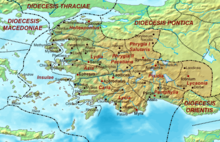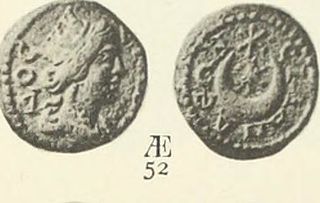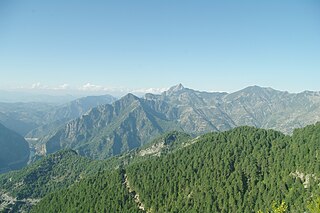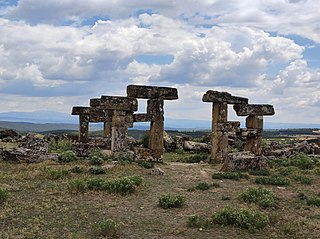
Sala or Salena was a town of ancient Lydia, and is a suppressed, vacant and titular see of the Roman Catholic Church. [1]

Sala or Salena was a town of ancient Lydia, and is a suppressed, vacant and titular see of the Roman Catholic Church. [1]
The town of Sala is identifiable with Kepecik in today's west Turkey, but in antiquity was an ancient episcopal see of the Roman province of Lydia in Asia Minor. It was part of the Patriarchate of Constantinople during Byzantine times and was suffragan of the Archdiocese of Sardis.
Sala is not mentioned by Michel Le Quien in his work Oriens Christianus [2] but a bishop Stephen is recorded in the episcopal lists of the second Second Council of Nicaea. [3] William Mitchell Ramsay in his The Historical Geography of Asia Minor (1890) claims that Le Quien's omission of Sala was due to his misreading the Greek records where he "invented" the bishopric of Helenopolis. [4]
Sala survives today as a titular bishop; the seat has been vacant since 27 January 1962. [5] [6]

Tripolis on the Meander – also Neapolis, Apollonia, and Antoniopolis – was an ancient city on the borders of Phrygia, Caria and Lydia, on the northern bank of the upper course of the Maeander, and on the road leading from Sardes by Philadelphia to Laodicea ad Lycum. It was situated 20 km to the northwest of Hierapolis.
Hierocaesarea or Hierokaisareia, from the Greek for 'sacred' and the Latin for 'Caesar's', also known as Hieracome or Hierakome, was a town and bishopric in the late Roman province of Lydia, the metropolitan see of which was Sardis. It was inhabited during Hellenistic, Roman, and Byzantine times.
Harpasa was a city and bishopric in ancient Caria in Roman Asia Minor, which only remains a Latin Catholic titular see.
Germanicopolis was an ancient town in Bithynia, also known as Caesarea in Bythinia (not to be confused with Caesarea Germanica, as such a former bishopric and present Latin Catholic titular see.

Silandus or Silandos was an episcopal city in the late Roman province of Lydia. It was near and gave its name to the present town of Selendi in Manisa Province, Turkey.
Arabissus or Arabissos, also known as Tripotamos, was a town in ancient Cataonia, then Cappadocia, and later in the Roman province of Armenia Secunda. The Byzantine Emperor Maurice was born there in 539. A cave of the Seven Sleepers is located in the Eshab-ı Kehf Kulliye.
Cotenna or Kotenna was a city in the Roman province of Pamphylia I in Asia Minor. It corresponds to modern Gödene, near Konya, Turkey.

Abonoteichos, later Ionopolis, was an ancient city in Asia Minor, on the site of modern İnebolu, and remains a Latin Catholic titular see.
Traianopolis, Trajanopolis, Tranopolis, or Tranupolis was a Roman and Byzantine city in Phrygia Pacatiana Prima.

Irenopolis or Eirenopolis or Eirenoupolis was an ancient Roman, Byzantine and medieval city in northeastern Cilicia, not far from the Calycadnus river, also known briefly as Neronias in honour of the Roman emperor Nero. Irenopolis was also an episcopal see that is now included in the Catholic Church's list of titular sees.
Zenopolis was an ancient Roman and Byzantine city in Isauria. Its site is located near Elmayurdu in Asiatic Turkey.

Blaundus was a Greek city founded during the Hellenistic period in Asia Minor, presently Anatolia, and is now a Latin Catholic titular bishopric.
Daldis, was a town on the borders of ancient Lydia and Phrygia, a former bishopric, and is now a Latin Catholic titular see. It also minted coins in antiquity with the legend Δαλδιανων. It also bore the name Flaviocaesaria or Phlabiokaisareia, which is not attested among ancient authors but is reconstructed from epigraphic and other evidence.

Tracula is a former Ancient city and bishopric in Asia Minor, which remains a Latin Catholic titular see.
Metropolis in Asia is both a Roman era city and a vacant titular see located in the ecumenical Province of Asia, in what is today Tratsa, Turkey and Haidarli
Anineta, also known as Aninetum or Anineton, was a town of ancient Lydia or of Caria, and later of the Roman, and Byzantine empires, located in modern Turkey, the site of an ancient bishopric in and was an important site early in christianity. Anineta remains today a titular see of the Roman Catholic Church in the ecclesiastical province of Ephesus. In addition it minted coins bearing the legend Ἀνινησίων.
Euaza, located in what is modern Turkey was a town during the Hellenic, Roman and Byzantine era. The town was in the upper portion of the Cayster River valley, about 100 km east from Ephesus. The town also known as Augaza, appears in Notitiea episcipum of the 9th century. The area is still mainly agricultural.

Hyrcanis or Hyrkaneis, also known as Hyrcania, was a Roman and Byzantine-era city and bishopric in ancient Lydia, now in western Turkey. It was situated in the Hyrcanian plain, which is said to have derived its name from a colony of Hyrcanians being settled here by the Persians. They were afterwards mingled with some Macedonians, who also settled in this district, whence they are called by Pliny the Elder and Tacitus "Macedones Hyrcani." The city minted its own coins.

Hermocapelia or Hermokapeleia, also possibly known as Thyessos, was a town of ancient Lydia. It was inhabited from Classical through Byzantine times. It stood on the Hermus River, "to the west of Apollonis in its own little plain almost completely surrounded by mountains."

Cinna or Kinna was a town of ancient Galatia. It was known as Zallara in the Hittite period. It was also the seat of a bishop; no longer a residential see, it remains a titular see of the Roman Catholic Church.